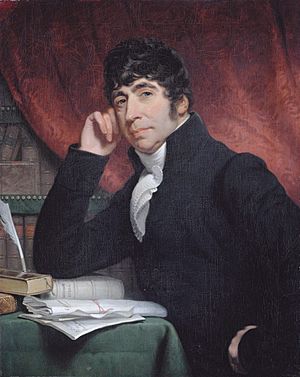Willem Bilderdijk facts for kids
Quick facts for kids
Willem Bilderdijk
|
|
|---|---|

Willem Bilderdijk (Charles Howard Hodges, 1810)
|
|
| Born | 7 September 1756 Amsterdam |
| Died | 18 December 1831 (aged 75) Haarlem |
| Occupation | lawyer |
| Nationality | Dutch |
| Alma mater | Leiden University |
| Genre | Poet |
Willem Bilderdijk (born in Amsterdam on 7 September 1756, died in Haarlem on 18 December 1831) was a famous Dutch poet, historian, lawyer, and language expert. He is known for his many writings and his strong beliefs.
Early Life and Education
Willem Bilderdijk was the son of a doctor in Amsterdam. When he was six years old, he had an accident that hurt his foot. This injury kept him from moving around much for ten years. During this time, he spent a lot of time reading and studying. He became very good at learning.
His parents strongly supported the House of Orange-Nassau, which was the royal family of the Netherlands. They also had strong Calvinist religious beliefs. Willem grew up with these same strong ideas about the monarchy and his faith.
After his childhood, Bilderdijk went to Leiden University. He studied law there and earned his degree in 1782. He then started working as a lawyer in The Hague.
Life in Exile and Return
In 1785, Willem Bilderdijk married Rebecca Woesthoven. Later, in 1795, a new government called the Batavian Republic took over the Netherlands. Bilderdijk refused to support this new government. Because of this, he had to leave the country.
He first went to Hamburg and then to London. In London, people were impressed by how much he knew. While there, he taught a student named Katharina Wilhelmina Schweickhardt. She was also a poet and the daughter of a Dutch painter.
In 1797, Bilderdijk moved to Braunschweig, and Katharina followed him. He divorced his first wife in 1802, and then he and Katharina were married.
In 1806, friends convinced Bilderdijk to return to the Netherlands. By this time, the Batavian Republic was gone. A new king, Louis Bonaparte, ruled the country. Louis Bonaparte was the brother of the French emperor Napoleon Bonaparte. King Louis liked Bilderdijk and made him his librarian. He also made him a member and later the president of the Royal Netherlands Academy of Arts and Sciences.
Bilderdijk even taught King Louis how to speak Dutch. There is a funny story that the king once accidentally called himself the "rabbit of 'Olland" instead of the "King of Holland" because he found Dutch pronunciation difficult.
After King Louis Bonaparte left the throne, Bilderdijk faced hard times and became very poor. When William I of the Netherlands became king in 1813, Bilderdijk hoped to become a professor. This did not happen, but he did become a history tutor at Leiden. He continued to speak out against new, liberal ideas until he died in Haarlem in 1831.
Bilderdijk also started a religious movement called "Het Réveil". This movement tried to offer Christian answers to the ideas that came from the French Revolution. Some of his students, like Isaac da Costa, followed his teachings.
Legacy and Remembrance
Willem Bilderdijk is still remembered today. A writer named Godfried Bomans once said that the bed Bilderdijk died in was kept until 1950. People could even come and look at it as a special item!
In 1885, a special stone was placed on the top of the house where he lived when he died in Haarlem. Another special stone is also in the St. Bavochurch. If you want to learn more about him, you can find many of his works at the Bilderdijk Museum collection, which is kept at Leiden University Library.
See also
 In Spanish: Willem Bilderdijk para niños
In Spanish: Willem Bilderdijk para niños


